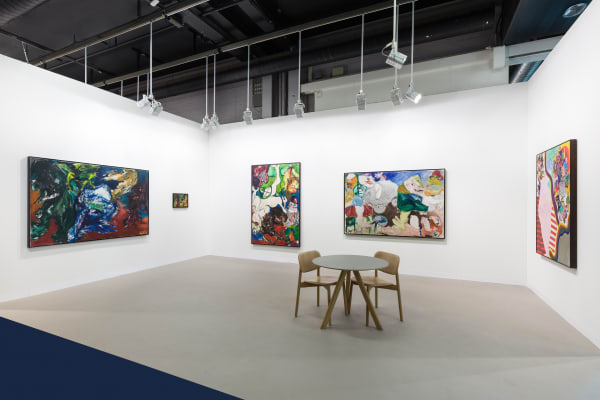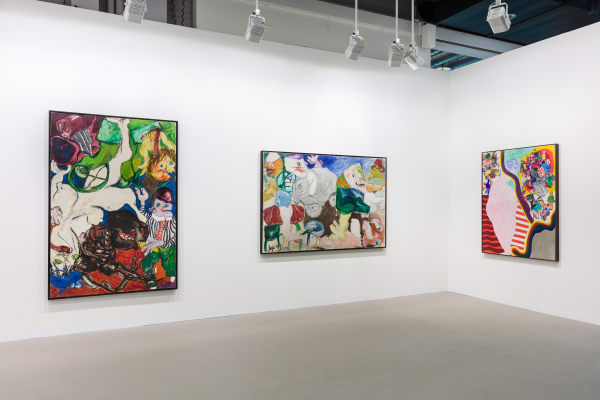Booth D16
On the occasion of Art Basel 2023, Pippy Houldsworth Gallery proudly presents a focused group of Jacqueline de Jong’s works from the 1960s, a formative decade in the artist’s development that saw her splinter from the radical Situationist International (SI).
The presentation highlights de Jong’s pioneering cultural contribution to an almost exclusively male international and intercultural avant-garde. Featuring rare and early works, many housed in international private collections since their execution, it explores the diversity of her expressive painting practice. The presentation comes at a time of increasing global recognition for de Jong, following recent solo museum exhibitions at Les Abattoirs, Toulouse; Stedelijk Museum, Amsterdam; WIELS, Brussels; MOSTYN, Wales; and Kunstmuseum Ravensburg. Her archive, the Jacqueline de Jong Papers, was acquired in 2011 by the Beinecke Library of Rare Books and Manuscripts, Yale University. In 2019 the AWARE Prize for Women Artists presented de Jong with the Outstanding Merit Award in recognition of her exceptional career. This week de Jong will be named Chevalier de l’Ordre des Arts et des Lettres by the French Ministry of Culture.
De Jong moved from her native Amsterdam to the 11th arrondissement of Paris in 1961. During the early 1960s, de Jong befriended German artists from Gruppe SPUR and former CoBrA member Asger Jorn, with whom she developed a romantic relationship beginning in 1959. De Jong had first encountered Guy Debord at the Stedelijk Museum in Amsterdam in 1960; through this meeting she familiarised herself with the theories of the SI and started to participate in the group’s activities, including conferences and meetings held at the Institute of Contemporary Arts, London (1960), and in Gothenburg, Sweden (1961). Between 1962 and 1967 she founded and edited The Situationist Times – publishing the first two issues in partnership with pataphysician Noël Arnaud – which was amongst the most important journals of the post-war period, both in form and content. Conceived as a rebuttal to the SI’s eponymous magazine, it bears witness to de Jong’s independent revolutionary spirit outside of the movement’s activities. Her archive, the Jacqueline de Jong Papers, was acquired by the Beinecke Rare Book and Manuscript Library, Yale University in 2011; it includes The Case of the Ascetic Satyr, a facsimile compilation of engravings, letters and ephemera commemorating de Jong’s relationship with Jorn. The booth features a vitrine of archival material, including copies of The Situationist Times and posters made by de Jong for the May '68 protests in France.
Alongside her editorial practice, de Jong assumed her own painting style; freed from the influence of older artists surrounding her, such as Jean Dubuffet, Wifredo Lam, Antonio Saura, Pol Bury and Asger Jorn, and those of her own age, like Robert Filliou, Daniel Spoerri, Antonio Segui, R.B. Kitaj and Peter Saul, she developed a visual language that combined monstrous figuration with themes of eroticism, death and violence, elucidating her own dark humour. Her work can be loosely associated with Nouvelle Figuration and was consequently shown at several salons in the early- and mid-1960s, including the Salon de Mai and the Salon Grands et Jeunes.
De Jong’s style at the advent of the decade can be seen in Til Akke (1961), an abstract painting enlivened with heavy impasto that was recently rediscovered after many years. Dated 3 March 1961, the day of Jorn’s 47th birthday, it is dedicated to Akke, de Jong’s nickname for him. The artist’s Accidental and Suicidal Paintings, begun in 1964, comprise carnivalesque compositions rendered with uninhibited brushstrokes. As expressions of the sexual revolution taking over 1960s Paris, they exhibit a dynamic and corporeal approach to both the personal and political. Rare Suicidal Paintings such as Le blouson très noir et ses femmes and Qu'il a mauvaise mine (both 1964) feature moribund iconography amidst their sprawling compositions; in both paintings a skeletal figure bares its teeth in a grin at once ghoulish and ecstatic. Meanwhile, in the vivid and little seen Accidental painting Les pazzes de la piazza (1965), a group of humanoid figures leer at each other across the canvas.
Against a backdrop of fast-moving political and social change, in which de Jong was an active participant, she explored the ascent of mass media and its impact on day-to-day life with the predominately black-and-white TV Drawings (1964-66), made to recreate the visual effect of a television set, something she herself did not own. As the decade progressed, her style acquired a pop sensibility. In La vie privée des Cosmonautes 'le cosmonaute invisible' (1966), de Jong explores a more narrative figuration in a vibrant, pastel palette. For the first time, de Jong was using acrylic paints, affording her greater speed and dexterity. The alienation of her astronaut subjects is enhanced by the painting’s zero-gravity composition. As the '60s came to a close, overwhelmed in France by change wrought by the upheaval of the May 68 unrest, de Jong embarked on the Erotic Paintings, a series based loosely on postcards sent to her by Jorn and shown in September 1968 at the Institute Néerlandais in Paris, and then later in 1969 at institutions throughout Norway.
Probing de Jong’s growth at a time of both personal and social change, the presentation demonstrates the authenticity of an artist navigating a unique moment in history as both a pioneer and as a woman, the two closely interlinked.
About the artist
Jacqueline de Jong (b. 1939, Hengelo, the Netherlands) lives and works in Amsterdam, the Netherlands, and in the Bourbonnais, France.
De Jong was named Chevalier de l’Ordre des Arts et des Lettres by the French Ministry of Culture in May 2023. In 2019 the AWARE Prize for Women Artists presented de Jong with the Outstanding Merit Award in recognition of her exceptional career. That same year, These are Situationist Times! (Torpedo Press, Oslo), an in-depth history of the publication, was launched at Stedelijk Museum, Amsterdam, and MoMA PS1, New York. Her archive, the Jacqueline de Jong Papers, was acquired in 2011 by the Beinecke Library of Rare Books and Manuscripts, Yale University.
Solo museum exhibitions include The Ultimate Kiss, WIELS, Brussels (2021), touring to MOSTYN, Wales (2021-22), and Kunstmuseum Ravensburg, Germany (2022); Pinball Wizard: The Work and Life of Jacqueline de Jong, Stedelijk Museum, Amsterdam (2019); Jacqueline de Jong, Les Abattoirs, Toulouse (2018-19); Jacqueline de Jong & The Situationist Times, Malmö Konsthall (2018-19); and Jacqueline de Jong: Undercover in de kunst, Cobra Museum for Contemporary Art, Amstelveen (2003). In 2024 she will have a major solo exhibition at the NSU Museum Fort Lauderdale, FL.
Recent group exhibitions include BPS22 Musée d'art de la Province de Hainaut, Charleroi (2023); Musée d'Art Moderne, Paris (2022 and 2017); The Warehouse, Dallas (2021); Lenbachhaus, Munich (2020); Frans Hals Museum, Haarlem (2018); and Musée des Arts Décoratifs, Paris (2018).
Collections include Stedelijk Museum, Amsterdam; Moderna Museet, Stockholm; Le Centre national des arts plastiques (Cnap), Paris; Musée les Abattoirs, Toulouse; Amsterdam Museum; Cobra Museum for Modern Art, Amstelveen; Frans Hals Museum, Haarlem; Museum Arnhem; Museum Boijmans van Beuningen, Rotterdam; Museum Jorn, Silkeborg; Henie Onstad Kunstsenter, Oslo; MONA Tasmania; Kunstmuseum Göteborg; Lenbachhaus, Munich; Rachofsky Collection, TX; and Musée d'Art Moderne de Paris.




